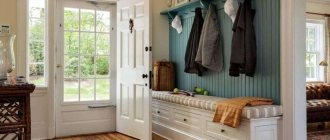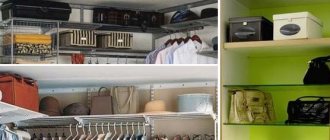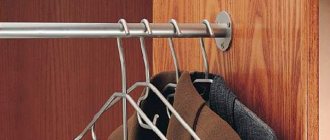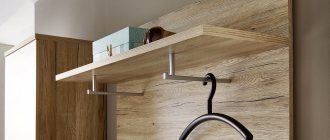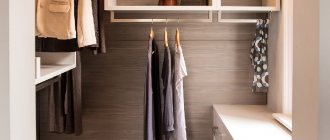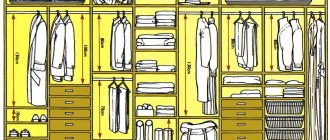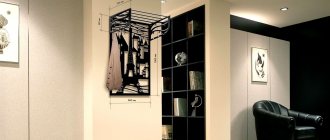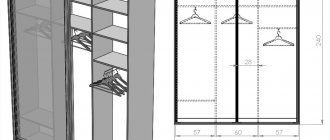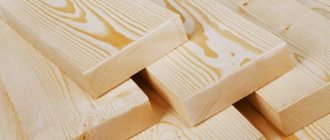8863 0 1
Andrey March 2, 2018 Specialization: facade finishing, interior finishing, construction of dachas, garages. Experience of an amateur gardener and gardener. We also have experience in repairing cars and motorcycles. Hobbies: playing the guitar and many other things that I don’t have time for :)
If you are planning to repair an old cabinet or make a new one from scratch, you will definitely be faced with the choice and installation of a rod. At first glance, this is a simple task, but in reality it contains many nuances. Therefore, I suggest you familiarize yourself with them, which will allow you to independently arrange a comfortable and reliable hanger in your closet.
The rod is a necessary element of any wardrobe
How much width space does clothing take up?
| 50 cm | 55 cm | 60 cm |
| not much, but possible | Fine | Very good |
* This is our down jacket (or fur coat). What about yours?
It is this size that, as a rule, limits the location of the clothes rail “along the back wall of the closet” and, accordingly, the internal depth of the closet.
The European standard for internal cabinet depth is 56 cm.
If your closet will store “light” outerwear (or children’s) clothing, such a rod can be used even with a shallower closet depth.
Important: sliding doors “eat up” approximately 10 cm from the full (external) depth of the cabinet. And here cabinets with regular hinged doors often come to the rescue.
General Tips
On the Internet you can find many photos of original designs. This will help you find planning solutions that everyone will like.
It is worth considering the following:
- There is no need to order a piece of furniture in which the shelves are located higher than you can reach.
- When creating a personal closet layout, you need to designate in advance the shelves that are required. Based on them, you can calculate the size of the rest.
- An accurate drawing of the wardrobe is required.
Standard cabinet sizes
Layout will become easier if you make a visual layout. Creating the interior of a cabinet yourself is not an easy task. But with a strong desire, you can achieve maximum comfort during operation. As time proves, hard work always brings excellent results.
Clothes size by height
| Clothes height including hangers | Height | |||
| 160 cm | 170 cm | 180 cm | ||
| Trousers with hangers folded in half | 65 cm | 72 cm | 80 cm | |
| Trousers on a special trouser hanger | 110 cm | 118 cm | 125 cm | |
| Jumper | 70 cm | 80 cm | 90 cm | |
| Shirt | 80 cm | 90 cm | 100 cm | |
| Blazer | 75 cm | 87 cm | 100 cm | |
| Jacket “below the waist” | 80 cm | 92 cm | 105 cm | |
| Knee-length coat | 90 cm | 103 cm | 116 cm | |
| Coat “below the knees” | 120 cm | 130 cm | 140 cm | |
What are clothes rails and what materials are they made from?
The issue of storing clothes requires a rational and organized approach. To solve this problem quickly and effectively, a clothes rail is used, which is a special device that allows you to keep wardrobe items in order and clean. Ease of use makes it popular among consumers and owners of sliding wardrobes.
Purpose and where it can be used
A modern clothes rail has one direct purpose - to neatly hang clothes in the closet. A large number of things is a problem familiar to every person. The use of hangers and hangers makes it easier to organize space in the wardrobe, and the rod allows you to place them.
To ensure that your closet is always in order and the search for the necessary clothes is not long, a rod is used. It is fixed along or across the garment, depending on its type. In addition, the use of two or three devices at once allows you to place wardrobe elements on several levels.
The clothes rail allows you to store:
- dresses - they are stirred by special internal straps;
- shirts - shoulder seams should be on the hanger, and buttons should be fastened;
- T-shirts – quick access to T-shirts will save time on ironing;
- blouses - should be positioned in the same way as shirts;
- outerwear - it will require reinforced hangers that can provide reliable fixation of jackets, coats and raincoats.
When selecting hangers, you should give preference to an anti-slip coating. This material will prevent clothes from rolling off their hangers and secure them comfortably in the closet.
Options located on the side panels allow you to conveniently organize the storage of ties, scarves and belts. A small gap between the fixture and the cabinet wall will save space. You can also additionally install second-tier rods and hang trousers and jeans on them. With this approach, the number of shelves in the closet will be reduced to a minimum.
Depending on the type of device, it can be used in two different ways: stationary and as an element of a wardrobe or wardrobe. The element finds another application in the dressing room as a separate element of the interior. The mobile rod for things conveniently moves around the room, and if necessary, hides in a secluded place. Hanging models are distinguished by their functionality due to the large gaps between the furniture panels: various types of clothing can be placed there.
How to place shelves correctly
The wardrobe has at least one section for folded wardrobe items, but to save space you need a lot of shelves. An important role is played by the distribution of things so that they are convenient to get from the racks.
In a private house
The distance between the shelves can be different, because objects of different sizes can be stored on them.
For example, shoes require more space compared to some small things that occupy a small part of the total closet space.
The standard space between shelves in a wardrobe where clothes are stored is 230–270 mm according to standard standards. Also, many people are concerned about the question of how many cm there should be between the shelves where the books are placed. The distance between bookshelves from each other should be 20–35 cm.
In the room
An overhead rack is usually needed for storing large items. It is advisable not to divide this compartment into several small ones in order to fit large items (suitcases, bags). The height of such a shelf should be 45–60 centimeters.
The shoe rack will be comfortable in everyday life if it is installed at a height of 20 cm from the floor covering. There is one caveat - the height between the shelf where the shoes are and the hanger should be approximately 150 cm.
Scheme with optimal shelving sizes
This will help prevent the bottom of your outerwear from coming into contact with your shoes for hygiene purposes. The optimal width of shelves can vary between 40 and 100 centimeters in different types of cabinets. It is not recommended to make the shelves more than 1 meter wide, as they will sag and wear out faster.
Variety of shapes
Dressing rods differ in their size, shape and arrangement. All existing species can be divided into several groups, taking into account their characteristics. To select a clothing storage device of the desired size and shape, it is recommended to review the classification summary table.
| Classification by shape | Types by type of fastening in a closet or dressing room | Classification by purpose |
| Oval is the most common option among users. This model is attached to a flange, which is fixed to the furniture board. The oval clothes rail has increased load capacity, which allows you to place outerwear on it - coats, winter jackets, down jackets. | Transverse – located in a closet or wardrobe system transversely to the product. Some cabinet owners do not accept this type, claiming that it is not convenient to use. On the other hand, this type of placement of the bar allows you to save space in the wardrobe, freeing it up for other things. | Retractable microlift - used in shallow cabinets, up to 50 cm deep. Convenience lies in the location perpendicular to the bottom, where one of the parts of the model moves forward, allowing a person to take the necessary thing. This device is fixed with self-tapping screws to the ceiling of the wardrobe system. |
| Round – fixed to the cabinet walls using special rod holders. This rod is suitable for storing medium-heavy items on hangers: blouses, shirts, skirts, trousers. | Longitudinal - a traditional rod for things, which is fixed parallel to the floor or bottom of the cabinet. It is comfortable to place hangers with clothes on it, and it is convenient to take them out at any time. | Pantograph - allows you to make the most efficient use of the entire cabinet space. Such a rod is attached near the ceiling of the wardrobe, and a special mechanism organizes the movement of the furniture elevator, thereby allowing you to get the right thing. |
| — | Floor-standing – is a separate structure that can be transported around the apartment. You can also hang hangers with clothes on the bar. This design is often used in theater dressing rooms. | A rod for accessories - such devices are placed on the doors of the wardrobe. It is convenient to store belts, scarves, ties and other items here. |
Practical materials
According to the production technology of clothing storage devices, all materials must be durable and reliable. Constant high load gradually pushes the bar, which can lead to its breakage. To prevent a sad outcome, it is recommended to take a closer look at the materials for the production of floor and hanging rods:
- Chrome steel is the most common material for clothing storage devices. The raw materials are highly reliable and can withstand heavy loads for a long time. If you install the product correctly, choosing the length of the rod correctly, it will last for many years without a single scratch;
- metal alloys - used for the production of rods for commercial purposes. For example, metal fixtures are well suited for organizing the storage of theatrical costumes, and can also serve as clothing racks in a store. Such a rod will be highly durable, but the appearance will not be attractive due to the lack of coating;
- galvanized steel. The production technology makes it possible to apply a special coating to the steel material, protecting the product from wear and corrosion. A hanging place for storing ties and scarves can be made from this material.
The method of installing the rod will depend on the parameters of the closet or dressing room. If it is narrow and small, it makes sense to use a longitudinal fastening. If the cabinet has good depth, you can perform a transverse installation.
How to choose a hanger
When choosing a clothes hanger, you should consider the following parameters:
- design features of the device;
- material of manufacture;
- presence/absence of additional functions.
Type of shelves by design
According to the type of design, wall hangers can be:
- vertical. It is compact, as it takes up a minimum amount of space in the hallway or other room, and has an unusual appearance, which allows you to achieve some design uniqueness. However, they are not suitable for storing a large number of things and items of clothing that are heavy (coats, fur coats, etc.). Therefore, the advantages of hangers made in a vertical design are used for storing hats, keys, purses and other small accessories;
Vertical wall hangers
- horizontal. These hangers are more common. They can withstand significant loads, which allows you to place a large number of different, including “heavy” clothes. A horizontal hanger can also be a separate piece of furniture.
Horizontal clothes hanger
The type of product is selected depending on the purpose. For accessories and small items of clothing or towels, you can choose vertical hangers, but in the hallway it is more advisable to install horizontal, more durable ones.
Manufacturing materials and their advantages
Most often used for the manufacture of wall hangers:
- tree;
- metal;
- plastic.
Wooden hangers (chipboard, solid wood, etc.) are different:
- environmental friendliness;
- variety of design;
- ability to withstand heavy loads;
- durability;
- ease of maintenance;
- variety of price categories. You can buy a simple hanger in a budget version or an expensive one made from rare wood species (beech, hornbeam, and so on).
Wooden hanger with custom design
A metal hanger has a greater safety margin and is more expensive compared to wooden devices. The following metals can be used for manufacturing:
- aluminum;
- steel;
- chromium;
- copper;
- bronze;
- cast iron.
Hangers can be made using various methods:
- casting Such products are distinguished by their large weight, massiveness and adaptability to heavy loads;
Die-cast hanger
- forging. Forged hangers are relatively lightweight. A professional can make openwork and at the same time durable products of various shapes.
Forged hanger
Standard mass-produced hangers are made from two materials: wood, which is used to make the frame of the product, and metal, used to make hooks.
Wood and metal hanger
Hangers are most rarely made of plastic, since such a thing is not strong and durable and can be used exclusively for small accessories, towels or light clothing.
Plastic hanger for light items and accessories
Additional shelf options
It is also recommended to select a product for the hallway, bathroom or kitchen depending on the size, number of hooks and additional accessories.
Hangers can be equipped with:
- shelves for storing gloves, knitted hats, scarves, bags and so on. Such interior items are characterized by large overall dimensions and capacity and can be made of wood or metal;
Wall hanger complemented by a shelf
- mirror. Hangers with mirrors are usually made for placement in the hallway. They are characterized by large overall dimensions and large capacity.
Wall hanger complemented by a mirror
If you purchase a hanger for a finished hallway, bathroom, etc., then it is advisable to select furniture in accordance with the design of other items or from the same series.

